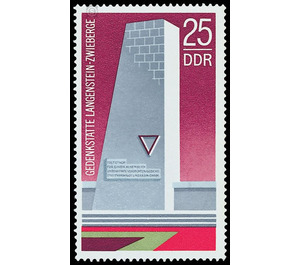Commemorative stamp series - Germany / German Democratic Republic 1973 - 25 Pfennig
Theme: Architecture
| Country | Germany / German Democratic Republic |
| Issue Date | 1973 |
| Face Value | 25.00 |
| Color | grey |
| Perforation | K 14 |
| Printing Type | Photogravure |
| Stamp Type | Postage stamp |
| Item Type | Stamp |
| Chronological Issue Number | 1620 |
| Chronological Chapter | GER-DDR |
| SID | 273525 |
| In 20 Wishlists | |
Memorial and Memorial Langenstein-Zwieberge In April 1944, the fascists began to build in the area of the counters and Zwieberge at the village Langenstein (district Halberstadt) underground hall and gallery systems for armaments production. The workforce was hired from the Buchenwald, Neuengamme and Sachsenhausen concentration camps. In less than a year, inhumane working conditions and driving methods killed 5,000 people from various European countries. 2,500 prisoners were shot dead on the death march to evacuate the camp. To commemorate the murdered fighters against fascism, the Ministry of Posts and Telecommunications of the German Democratic Republic issued a multicolored postage stamp. Langenstein-Zwieberge Remembrance and Memorial Center Near Halberstadt, in the northern foothills of the Harz Mountains, in September 1949, the victims of fascism, the fighters for peace and democracy, were murdered in the fascist concentration camp Langenstein-Zwieberge - a subcamp of Buchenwald Inmates erected a first reminder and memorial. To reminisce even more vividly the anti-fascist struggle and the victims of this heroic wrestling, a reorganization of the Langenstein-Zwieberge memorial and memorial was carried out on the basis of plans by a Magdeburg architectural collective. The drawings were made within the framework of the National Building Project and the design proposals were made known to various sections of the population through various measures. Hundreds of individuals and nearly 60 collectives, including officers and soldiers of the National People's Army and the Soviet garrison Halberstadt have been actively involved in the transformation. This new, worthy memorial rises above the grounds of the entire former storage area. The four large mass graves are included in the plant. On the perimeter wall is a tower, on which there is a flaming bowl of pure copper. The special postage stamp issued at the suggestion of the Committee of Antifascist Resistance Fighters in the German Democratic Republic shows the commemorative column bearing the following inscription coined by Bertolt Brecht: Step forward - For a moment, unknown, covert view And receive our thanks. Langenstein-Zwieberge was an external camp of the concentration camp Buchenwald, which was built on the Ettersberg near Weimar in 1937 by inmates under inhumane conditions. The Buchenwald main or main camp included numerous satellite camps, which were literally "supplied" by the cheapest labor force, the concentration camp inmates, especially from Buchenwald. The external camp Langenstein-Zwieberge, which was erected in the spring of 1944, was created under the conditions of "wartime necessity" and was therefore under the responsible Amtsgruppe "C" (war production) in the Reich Security Main Office of the SS. This camp was a typical example of the close interdependence and cooperation between the German Armament capital, the Hitler government and the leadership of the SS. The notorious Junkerswerke (AG) had among others also in Halberstadt important works for the fascist armaments production furnished. Under the impression of the changed conditions of war, above all also the advance of the heroic, Soviet army, the forces responsible for the supply of the Hitlerite troops with war material were compelled, the arms production - to which also the production of individual parts belonged for the so-called V-weapons - to move into underground, safe from the bombardments production plants. Such subterranean tunnels were also driven into the elevations of the Harz foreland, the Thekenbergen and Hoppelbergen, in the immediate vicinity of Langenstein-Zwieberge. For the work 10,000 prisoners from nearly 20 countries were used. More than 7,000 people were miserably destroyed, tortured, hanged, slain, murdered under the fascist slogan: "extermination by forced labor". There were not many who still had the strength to survive the torture hell of Langenstein-Zwieberge and return to their homeland. As in all other fascist concentration camps, anti-fascist resistance was also carried out in the Langenstein-Zwieberge concentration camp. In particular, tried and tested and battle-tested members of the Communist Party of Germany played a leading role in its organization and implementation. These revolutionary workers' officials, educated and educated by Ernst Thalmann's party, acquired the ability to organize the struggle against the SS under the particularly difficult and complicated conditions of this concentration camp. In the foreground stood the application of the principles of proletarian internationalism and effective solidarity. Especially for the preservation of the life of Soviet officers, soldiers and young people, German Communists put their lives here every day as well. German anti-fascists from nearby Halberstadt searched for and found ways to contact the inmates and provide them with food. Already at that time it was confirmed that for the German Communists international solidarity and friendship with the Soviet people was a matter of the heart and practical action. In Langenstein-Zwieberge is a truly worthy reminder and memorial. It was erected to commemorate the anti-fascist struggle and the victims in this fascist concentration camp. Above all, it urges the living, and especially the young generation, to be ever vigilant, always fighting for peace and against neo-fascism, revanchism and militarism. Some killers of Langenstein-Zwieberge still live unmolested in the FRG today. West German monopoly capital and the neo-fascists of all shades have not abandoned their fateful plans. More than ever, therefore, the inscription on the tower wall to the rising of the memorial and memorial Langenstein-Zwieberge has full validity: "Nobody has the right to forget, And no one may forget, For the sake of life, for the sake of humanity."


